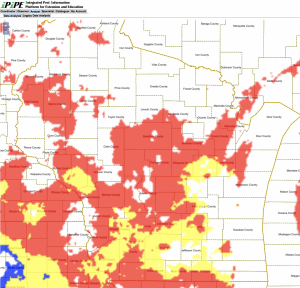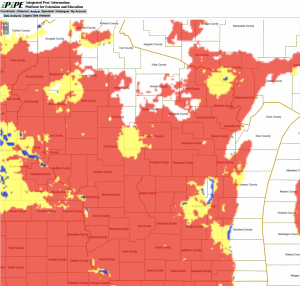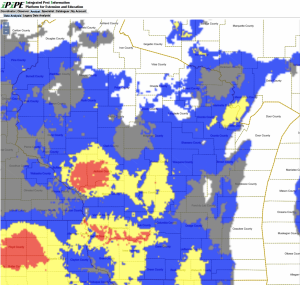Wisconsin White Mold Risk Maps – July 21, 2017
Damon L. Smith, Extension Field Crops Pathologist, University of Wisconsin-Madison
Jaime Willbur, Graduate Research Assistant, University of Wisconsin-Madison
Sclero-cast: A Soybean White Mold Prediction Model
**This tool is for guidance only and should be used with other sources of information and professional advice when determining risk of white mold development. We encourage you to read the model how-to guide which can be downloaded by clicking here**
Higher average temperatures this week helped to decrease white mold risk in non-irrigated fields in some locations in the southern and south-central portion of the state (Fig. 1). However, risk remains high in the central area of the state and in portions of the western region.
Areas of high risk have increased in irrigated soybeans planted to 15-inch rows (Fig. 2). Soybeans planted to 15-inch rows and irrigated are under high risk for white mold development in much of the state of Wisconsin. This is consistent with our field observations. Our crew has mostly found apothecia (the small, cup-shaped mushroom) in fields that are irrigated and planted to the 15″ row-spacing. Risk of white mold increased slightly in several pockets along the Wisconsin River Valley and in Jackson and Trempealeau Counties for soybeans planted to 30-inch rows and irrigated (Fig. 3).
Forecasts indicate cooler weather next week. This may increase risk further in some areas, depending on where dew and rain events occur. Continue to growth-stage soybeans and note that map predictions should be considered for making white mold management decisions if soybeans are flowering AND soybean canopies are nearly closed. For more information on white mold and white mold management, see this previous post.
Map Legend: White = model is inactive and risk of apothecia in the field is likely low; Gray = apothecia might be present, but likelihood of apothecial presence is less than 5%; Blue = low risk of apothecia in the field (5 to <15% chance); Yellow = moderate risk of apothecia in the field (15 to <30% chance); Red = high risk of apothecia in the field (30% or higher chance). Model predictions must be combined with soybean growth stage and canopy characteristics to aid in timing of fungicide sprays.
These models were developed at the University of Wisconsin-Madison in conjunction with Michigan State University and Iowa State University to identify at-risk regions which have been experiencing weather favorable for the development of white mold fungus apothecia. Weather information and maps are provided by the Soybean Integrated Pest Information Platform for Extension and Education (iPIPE), which is managed by ZedX, Inc. This model predicts when apothecia will be present in the field using combinations of 30-day averages of maximum temperature, relative humidity, and maximum wind speed. Using virtually available weather data, predictions can be made in most soybean growing regions. Based on these predictions, a map is generated under three scenarios (non-irrigated soybeans, soybeans planted on 15″ row-spacing and irrigated, or soybeans planted on 30″ row-spacing and irrigated). The maps are colored to show the likelihood of apothecial presence within a region. If the model is predicting high risk (red) in your area for your planting scenario, the soybeans are flowering, and the canopy is somewhat closed, then the white mold risk is elevated. If your fields are at-risk, we recommend to consult your local extension personnel or resources for the best in-season management options for your area For further information on how to use and interpret these risk maps, CLICK HERE to download a how-to guide.





